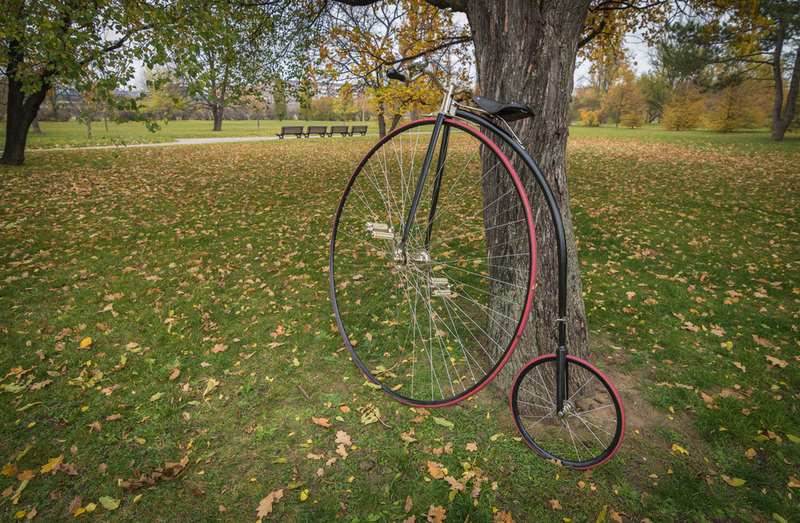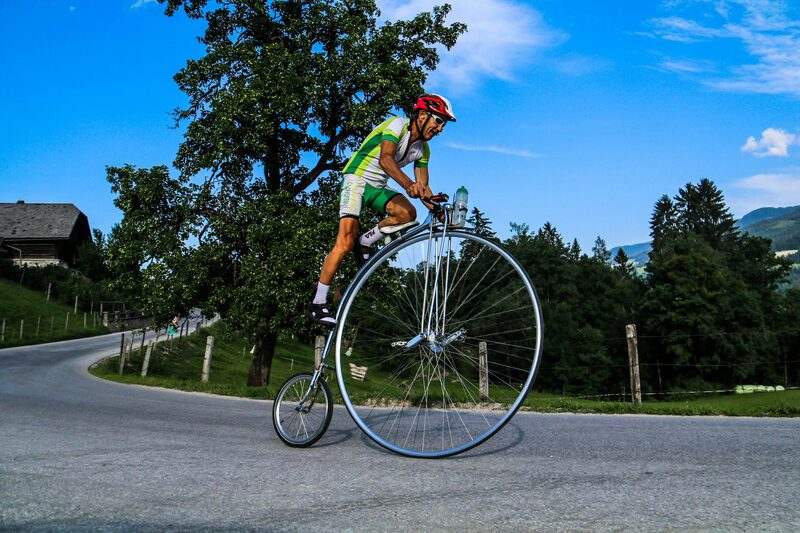Did you know the front wheel of a penny-farthing bicycle can be as big as 52 inches? That’s like having 52 gears because the cranks are directly attached to that huge wheel! Let’s find out what made this bike so special back in the 19th century.
This bike’s design changed how riders felt, offering both thrill and challenge. Today, we’ll share the top 10 facts about the penny-farthing. We’ll cover its unique build and its role in history. Get ready for a journey through time with this iconic bike!
Introduction to the Penny-Farthing Bicycle
The penny-farthing bicycle came out in the 1860s, marking a big change in cycling history. It was made to improve on the “boneshaker” velocipede. Eugène Meyer was key in making this bike, leading to big steps forward in cycling.

The bike’s unique penny-farthing wheel size made it go faster than others. This made it stand out from earlier bikes.
Between 1874 and 1886, the penny-farthing became popular among the city’s upper class, especially young men. Its big front wheel and small back wheel made it look different. But it also raised safety concerns.
As time went on, cycling became more about personal identity and fun. This changed how bikes were made and used.
The penny-farthing’s history is filled with racing and endurance. Racing started in 1986, and European championships were held in Belgium every year. Even though the safety bike came in the 1890s, the penny-farthing is still seen as a key part of bike history.
What is a Penny-Farthing?
The penny-farthing is a key part of penny-farthing bicycle history. It has a unique design that stands out. This makes it popular among cycling fans and collectors.
Unique Wheel Design
The penny-farthing’s most notable feature is its peculiar penny-farthing construction. It has a big front wheel, usually 48 to 54 inches in diameter. This big wheel helps riders go faster with each pedal.
The smaller rear wheel helps keep the bike stable. This design also helps absorb shocks from rough roads. But, it can be hard to balance, needing the skill to ride safely.

Positioning of the Rider
Riders sit high on the big front wheel, facing challenges. Getting on and off is tricky because of the high center of gravity. Often, a foot-peg is needed for help.
This high seat gives riders a great view but also raises the risk of accidents. The way the rider pedals makes the bike go fast, attracting many cyclists.
What was unusual about the penny-farthing bicycle?
The penny-farthing bicycle was a key symbol of the late Victorian era. It had unique features that made it stand out. These features added to its charm and the thrill of riding it. Knowing about its engineering helps us see why it was so popular in the 1870s and 1880s.

Peculiar Construction Features
The penny-farthing’s design was quite unusual. It was mostly made of metal. It had:
- Wire-spoked wheels for better strength and less weight
- Solid rubber tires for longer life and better performance
- A direct-drive system, where pedals and cranks are connected straight to the hub for better power transfer
The front wheel could be up to 5 feet (152 cm) in diameter. This meant riders could go further with each pedal stroke. It made the penny-farthing different from other bikes, which had smaller wheels and wooden frames.
Speed and Performance Considerations
The penny-farthing was fast and powerful, making it a hit among racers. Its big front wheel helped cyclists go faster than others. But, this speed came with big risks:
- Riders often fell off because of the bike’s height and hard braking
- Trying to stop suddenly could lead to serious accidents, with riders flying over the handlebars
Despite these dangers, many were drawn to the penny-farthing’s thrill. Thomas Stevens, for example, rode one around the world. The mix of speed and unique design made it a memorable part of cycling history.
Historical Context of the Penny-Farthing
The penny-farthing bicycle is a key part of cycling history. It shows how society and technology changed in the late 19th century.
Invention and Modifications
For those wondering who invented the penny farthing, the invention is often attributed to Eugène Meyer, who in 1869 created the first high-wheeler, a precursor to the famous design. This early version quickly gained popularity. However, it was in the 1870s that James Starley made significant advancements to the model.
Starley’s Ariel design introduced hollow frames and wire-spoked wheels, innovations that made the bike both stronger and lighter. These improvements were critical in making bicycles not only faster but also more reliable.

Influence of James Starley
James Starley changed the penny-farthing for the better. He made bikes safer and more efficient. He used new tech like ball bearings.
Starley’s work made bikes safer and more comfortable. His ideas helped create the Rover Safety Bicycle. This bike was a big step towards safer riding.
Development of the Modern Bicycle
The penny-farthing’s popularity declined in the 1880s. This was when safer bikes came out. John Kemp Starley, James’s nephew, made the Rover Safety Bicycle.
This bike had a chain drive and better balance. It was safer than the high-wheelers. The need for safety led to the use of pneumatic tires. Today, bikes are much more advanced and safe.
Top 10 Fun Facts About the Penny-Farthing

-
- The penny-farthing gets its name from two coins: the big penny (front wheel) and the tiny farthing (back wheel)!
- The term “penny-farthing” was first written down in 1891—years after the bike was invented.
- Riders could go faster on a penny-farthing than most bikes of the time, but the speed came with serious risks!
- Falling off a penny-farthing was known as “taking a header,” and it wasn’t a fun experience!
- Women rarely rode penny-farthings because their long dresses made balancing super tricky.
- Penny-farthings still appear in movies and events today, bringing old-school charm to the modern world.
- Even though safer bikes came out in 1885, penny-farthings are still being built today!
- People still race penny-farthings in special events! Yes, they compete on these wild wheels.
- Riding a penny-farthing isn’t for the faint of heart—you’re perched about 4 feet off the ground!
- Despite their quirky design, penny-farthings remain a beloved symbol of vintage cycling.
FAQs
Who invented the penny-farthing bicycle?
Eugène Meyer’s work influenced the penny-farthing. James Starley made big improvements in the 1870s. He’s known as the “father of the cycle industry.”
What was unusual about the penny-farthing bicycle?
The penny-farthing stands out for its big front wheel and small rear wheel. This design affects balance and riding, making it both interesting and challenging.
What are the features of a penny-farthing bicycle?
It has a large front wheel (48 to 54 inches) for speed and a smaller rear wheel for stability. This mix creates a unique ride.
What makes the design of the penny-farthing bicycle unique?
Its design is special because of the big front wheel and small rear wheel. It also has an elevated seat and is made of metal, like wire-spoked wheels and solid rubber tires.
Are there any safety concerns associated with riding a penny-farthing?
Yes, riding a penny-farthing is risky. Its high center of gravity can cause falls, especially if the front wheel hits something.
What is the historical significance of the penny-farthing bicycle?
The penny-farthing marked a big step in bicycle design. It allowed for faster speeds and led to safer bikes, like the Rover Safety Bicycle.
Why is it called a penny-farthing?
It’s called a penny-farthing because of its wheel size. The big wheel is like a penny, and the small one is like a farthing coin.
What challenges do riders face when using a penny-farthing?
Riders face many challenges. These include hard mounting and dismounting, the risk of falling and needing to balance well to avoid obstacles.






